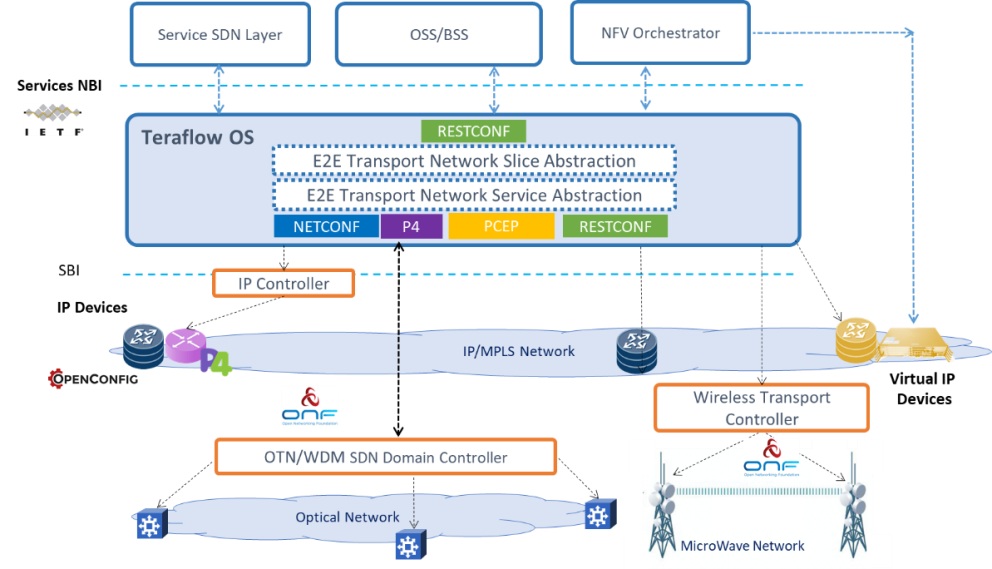Network Operators are embracing a transformation process to make the network fully programmable, autonomous and its resources sliceable with customer control.
With 5G networks comes the opportunity to deploy new services in the network in an automated manner. Network operators can migrate to 5G based on templates for services and network slices hard-coded into their systems. In this case, each service and/or network slice selects its deployment type from a list of predefined specifications, defining specific network resources and having requirements or constraints.
However, this approach does not scale for Beyond 5G scenarios, where the network should adapt to the end users’ needs in a dynamic and on-demand manner. This means that the network (operated by the network slice controller) should compute a deployment plan (considering relevant and needed network service functions) together with a service provisioning and configuration plan. This needs to be done dynamically and intelligently to match the requested service, provide adaptation capabilities during the service operation, and relate the requested services to the specific underlying network resources that are offered and available. If most of the services will require resources from different domains, these network resources need to be orchestrated to provide multi-layer and multi-domain services. Network automation is the only way to deal with such adaptive environments. SDN promised the capability to program the network, and there are tools to do it. However, each tool has its own APIs, their associated data models may vary and be proprietary, so integration is a costly and time-consuming process.
Recent posts
The TeraFlow OS SDN Controller aims at mitigating the challenges just mentioned by supporting a set of operator-driven use cases and workflows. The use cases cover, for example, the management and provisioning of various types of services (such as Layer 2/3 Virtual Private Networks, optical connections, Microwave links…), Traffic Engineering, Topology discovery and slice provisioning and management. Teraflow OS supports the use cases based on fully standard South-Bound Interfaces (SBI) towards the network forwarding planes, North-Bound Interfaces (NBI) to Operation Support Systems and other management elements and a capability to abstract network resources to upper layers
While SDN is possible using per-vendor approaches, its advances and adoption are severely harmed with proprietary solutions. Hence, Teraflow OS is fully committed to work on open interfaces. For example, the optical network domain can be managed using the OpenConfig terminal device data models and/or the Open Networking Foundation (ONF) Transport API (TAPI). The microwave transport network follows the ONF Technical Reference (TR) 352 and/or Internet Engineering Task Force (IETF) Network Topology data models. Physical and virtual L3 routers can be controlled using OpenConfig data models.
The TeraFlow OS SDN Controller aims at mitigating the challenges just mentioned by supporting a set of operator-driven use cases and workflows. The use cases cover, for example, the management and provisioning of various types of services (such as Layer 2/3 Virtual Private Networks, optical connections, Microwave links…), Traffic Engineering, Topology discovery and slice provisioning and management. Teraflow OS supports the use cases based on fully standard South-Bound Interfaces (SBI) towards the network forwarding planes, North-Bound Interfaces (NBI) to Operation Support Systems and other management elements and a capability to abstract network resources to upper layers
While SDN is possible using per-vendor approaches, its advances and adoption are severely harmed with proprietary solutions. Hence, Teraflow OS is fully committed to work on open interfaces. For example, the optical network domain can be managed using the OpenConfig terminal device data models and/or the Open Networking Foundation (ONF) Transport API (TAPI). The microwave transport network follows the ONF Technical Reference (TR) 352 and/or Internet Engineering Task Force (IETF) Network Topology data models. Physical and virtual L3 routers can be controlled using OpenConfig data models.
Teraflow Testbed
The testbed envisioned to demonstrate the use cases belonging to the autonomous network beyond 5G involves multiple partners and facilities.
The Future Network Lab testbed at Telefonica premises in Madrid provides a replica of an operator’s network, with IP/MPLS routers (both physical and virtual), controlled via Openconfig, Optical networks, accessible via TAPI and Microwave links. The microwave devices are provided by SIAE and provide netconf with ONF T5-352 support. In adition, a 32-port 400 GbE Intel Tofino-2 P4 switch, acting as a high-performance network fabric, provides additional features and is controlled via the P4 driver.
The ADRENALINE testbed® at CTTC premises provides an SDN/NFV packet/optical transport network and edge/core cloud infrastructure for 5G and Internet of Things (IoT) services. The lab at CTTC also hosts its Kubernetes-based infrastructure to execute the TeraFlow OS instance, the TAPI-enabled Open Line System (OLS) controller, and the underlying optical transport network infrastructure.

